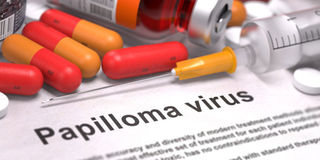Understanding the Human Papilloma Virus

The Human Papilloma Virus (HPV), a sexually transmitted virus that causes cervical cancer among women.
What you need to know:
Silent killer. Dr Solomon Kibudde, a Physician at the Uganda Cancer Institute explains the Human Papilloma Virus (HPV), a sexually transmitted virus that causes cervical cancer among women.
What is Human Papilloma Virus (HPV)?
HPV is a virus that is a sexually transmitted from one person to another, largely through sexual intercourse.
When someone acquires this virus, it causes inflammation and over period, it causes damage to the body. That damage, if not detected and treated early, can eventually cause cancer.
For instance, in women, once they acquire this infection due to HPV, it causes inflammation at the cervix, which is literally the mouth of the womb.
So, it causes the inflammation, which a woman may experience in form of pain, and occasional bleeding after sexual intercourse, and overtime that may progresses to cause other changes on the cervix, which are known as pre-malignant states. After sometime, it progresses into a full cancer.
On the other side in males, a bit unknown to public is that this infection causes cancer of the penis. It causes inflammation on the fore skin and eventually wounds, which don’t heal. Eventually these wounds turn out into cancer.
Types
This cancer has several types, but type 16 and 18 are very important for us to note because they are common in most cancer cases.
The two cancers of the cervix and penis are both treatable if they are in the early stages through surgery. But if they reach the advanced stages, it is not curable, we just treat to reduce pain, improve and prolong life. To recoup, this cancer is caused due to sexual intercourses.
Signs
Among the signs of HPV is pain in the lower abdomen that is usually chronical and not responding to antibiotics.
Other signs included bleeding during and after sexual intercourse. There will be observation of blood immediately after sexual intercourse. Later on there is onset of a discharge which is watery and foul smelling and eventually bleeding through the vagina. Those are some of the signs that indicated advanced stages of the disease.
Other following signs are that a person will start developing constant fever, loss of appetite, and eventually lose weight.
And in more advanced stages, they develop severe low back pain and bone pain and other symptoms showing lack of blood a condition called anemia.
Advice
People should always visit health centres for health checkups and screening because it is the only way we can easily manage and treat the diseases before it inflicts heavy health damage of the person.
The Vaccine
The good news is that today we have a vaccine that has been rolled out by the government into schools. So young children can get a vaccine before they are exposed to sexual intercourse and this reduces their risks of being exposed to the cancer virus.
This vaccine covers basically strain 11 and some 16 and those two cause a big proportion of cervical cancer, so we are hopeful that its rollout will go a long way in to control cervical cancer, which is number one cancer in the country.
And the reason is that it is associated with HIV, despite the latter going down, we are observing a parallel trend in the two infections.
Risks
For cervical cancer, the main risk is infection and infection has two categories, usually there are those chronical infections such as HIV and the HPV.
These infections are acquired through multiple sexual partners, risky sexual behaviors, and untreated Sexual Transmitted Infections (STIs), so if you have one STI, it increases the risk of catching another STI, and these are some of the common risky factors that cause cervical cancer.
In summary, cancer of the cervix is a sexual induced cancer and this applies to both male and female.




